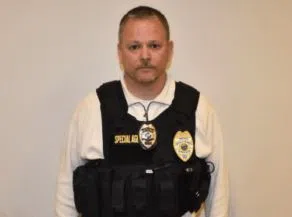
ST. PAUL, Minn. (Minnesota Reformer) – A deputy superintendent of the state crime bureau, who is in charge of use-of-force investigations, faces a complaint that he lied about his own use of force when he shot an unarmed man while apprehending him.
The incident happened in 2017, when police were looking for Eddie Markeith Frazier in connection with the murder of a woman found dead in a bathtub in her downtown Crookston apartment.
Scott Mueller, a Bureau of Criminal Apprehension deputy superintendent, shot Frazier after he was spotted in his vehicle about a mile west of the Mall of America in Bloomington, according to a Forum News story. Mueller is one of three deputy superintendents at the BCA and as of 2020, heads up investigatory services, including deadly use-of-force investigations.
The Hennepin County Sheriff’s Department said when officers approached Frazier’s vehicle, “shots were fired” and he fled on foot; a six-hour manhunt ensued. The BCA said at the time one of its agents had discharged his weapon and that Frazier “was transported to an area hospital after he was taken into custody.” The statement didn’t say whether Frazier had been shot.
BCA spokesperson Jill Oliveira released a statement saying Mueller’s use of force was independently investigated by the Hennepin County Sheriff’s Office and reviewed by the Hennepin County Attorney’s Office, which declined to pursue charges against him.
However, an expert hired by Frazier for his civil lawsuit against Mueller said the findings of that investigation are “irrelevant,” given Mueller has changed his story about why he used deadly force.
Frazier, who was convicted of the Crookston murder, sued Mueller in October 2022. In the course of that case, his attorney, Eric Rice, says he found Mueller may have provided false or misleading information and engaged in unjustifiable deadly force on Frazier by shooting him in the arm.
Frazier has filed a complaint with internal affairs alleging Mueller initially justified the shooting because he said Frazier’s vehicle was driving toward BCA agents, and he feared they’d be hit if he didn’t fire his weapon.
But there was no bullet hole in Frazier’s windshield, and an expert hired by Rice concluded the bullet went through the open passenger window, struck Frazier’s arm and exited through the open driver’s side window.
Rice says Mueller’s statement has changed since his first statement to investigators.
In the civil case, Mueller said Frazier’s arm movement made him think Frazier was raising a weapon toward officers. Rice said Frazier didn’t have a gun.
Rice hired Edward T. Flosi, a retired San Jose police officer who owns a consulting firm and testifies as a use-of-force expert. Flosi wrote in his report that Mueller — standing in the middle of the street with a rifle — initially said he fired because Frazier drove directly at the agents, coming within 10 feet of them.
Prosecutors did not charge Mueller for that reason, Flosi’s report says.
Mueller later said he probably fired at Frazier’s car as it was turning, but he was unsure.
Mueller said he fired due to Frazier’s violent background, criminal history, involvement in the drug trade, and because he was a murder suspect and was “careening at myself and my partners.”
Flosi wrote that despite Mueller’s claim of self-defense, he intentionally placed himself in the path of the oncoming car when he got out of his vehicle and stood in the middle of the street. Mueller should’ve stayed behind his vehicle for cover and avoided creating the situation where he fired at Frazier, Flosi concluded.
The BCA deadly force policy says agents are discouraged from firing at a moving vehicle unless deadly force is authorized.
“Some of the statements have changed since the initial investigation and it appears that all the agents now concede that Frazier’s vehicle was turned sideways in the roadway facing west when Mueller actually fired his shot,” Flosi wrote. “In that position, it can be reasonably deduced that no agents were in immediate danger of being run over by Frazier’s vehicle.”



Comments